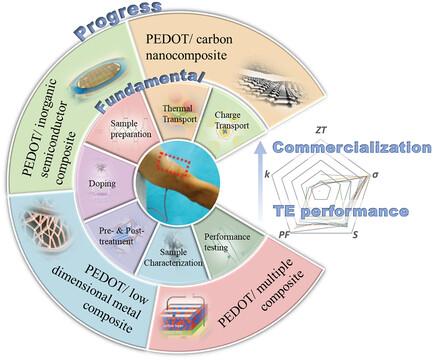基于纳米技术的 PEDOT 及其复合材料在可穿戴热电应用中的进展
IF 11.1
Q1 MATERIALS SCIENCE, MULTIDISCIPLINARY
引用次数: 0
摘要
热电材料的独特优点备受关注。其中,热与电的直接转化使这种材料具有潜力。人体能量以热的形式释放,可穿戴热电材料可将热能转化为有效的电能。基于纳米技术的材料可提高热电特性和纳米结构的吸热能力,有助于保持良好的导电性并降低导热性。聚(3,4-亚乙二氧基噻吩)(PEDOT)因其高导电性、柔韧性和良好的透明度等优点而被广泛研究。本文回顾了其机理,介绍了基于纳米技术的 PEDOT、无机半导体复合材料和低维金属复合热电材料的制备技术和热电特性。具体讨论了 PEDOT 基热电材料的最新研究进展、可穿戴式低维 PEDOT 基热电材料的应用,以及提高 PEDOT 基复合材料热电性能、器件设计和商业化的方法。本文章由计算机程序翻译,如有差异,请以英文原文为准。

Advancements in Nanotechnology-Based PEDOT and Its Composites for Wearable Thermoelectric Applications
Thermoelectric materials’ unique merits attract considerable attention. Among those merits, the straight transformation between heat and electricity makes this material potential. The energy of the human body is released in the form of heat, which can be transformed into effective electricity by wearable thermoelectric materials. The nanotechnology-based materials improve thermoelectric properties and heat absorption abilities for nanostructures will help maintain good electrical conductivity and reduce thermal conductivity. Poly(3,4-ethylenedioxythiophene) (PEDOT) is extensively investigated for its high conductivity, flexibility, good transparency, and so on. This article reviews its mechanism and describes the preparation techniques and thermoelectric properties of nanotechnology-based PEDOT, inorganic semiconductor composite, and low-dimensional metal composite thermoelectric materials. The recent research progress on PEDOT-based thermoelectric materials, the application of wearable low-dimensional PEDOT-based thermoelectric materials, and methods to improve the thermoelectric performance of PEDOT-based composite materials, device design, and commercialization are specifically discussed.
求助全文
通过发布文献求助,成功后即可免费获取论文全文。
去求助
来源期刊
CiteScore
14.00
自引率
2.40%
发文量
0
期刊介绍:
Small Science is a premium multidisciplinary open access journal dedicated to publishing impactful research from all areas of nanoscience and nanotechnology. It features interdisciplinary original research and focused review articles on relevant topics. The journal covers design, characterization, mechanism, technology, and application of micro-/nanoscale structures and systems in various fields including physics, chemistry, materials science, engineering, environmental science, life science, biology, and medicine. It welcomes innovative interdisciplinary research and its readership includes professionals from academia and industry in fields such as chemistry, physics, materials science, biology, engineering, and environmental and analytical science. Small Science is indexed and abstracted in CAS, DOAJ, Clarivate Analytics, ProQuest Central, Publicly Available Content Database, Science Database, SCOPUS, and Web of Science.

 求助内容:
求助内容: 应助结果提醒方式:
应助结果提醒方式:


